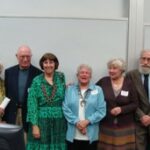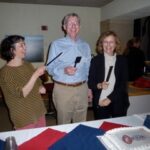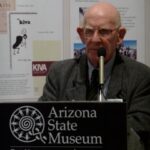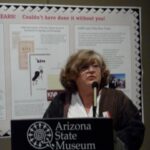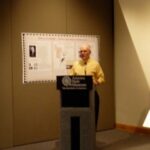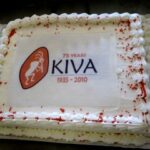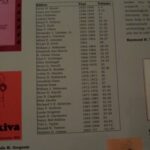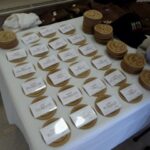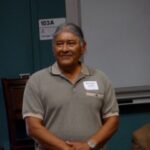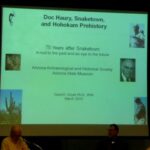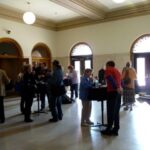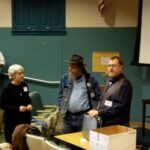- Tag

WAITING LIST ONLY
Tumamoc Hill just west of the Santa Cruz river in downtown Tucson is a trincheras site with occupations going back to 500 BC. There are also a large number of Hohokam petroglyphs. Our leaders will be Hohokam scholars Paul and Suzanne Fish and Peter Boyle and Gayle Hartmann who led the AAHS rock art recording project on the hill. To register email Katherine Cerino. The trip is limited to 30 people.

In the 1960s and 1970s, Arizona Archaeological and Historical Society volunteers, University of Arizona students, and Pima College students excavated Whiptail Ruin, a village in the northeastern Tucson Basin that dates to the mid- to late A.D. 1200s. Analyses of the notes and artifacts from the site are now finished, with some interesting results.
Whiptail Ruin, situated in and around Agua Caliente Park and its hot springs, contains evidence that some of its residents were part of a thirteenth-century migration from the Mogollon highlands. Locally made corrugated pottery, Cibola White ware jars used as cremation urns, obsidian from the Mule Creek source near the Arizona-New Mexico border, and the use of tree-ring datable conifer wood in house building are indicators of strong ties with people outside of the Tucson Basin.
Other evidence suggests that Whiptail’s residents may have been specialized hunters. Skulls, jaws, horns, antlers, and lower leg bones of deer, pronghorn, and bighorn sheep appear to have been stored on shelves or on the roofs of houses. If the Hohokam were doing what historic O’odham hunters did, some of these items may have been parts of hunting costumes, while others were pieces stored away to protect the other villagers from the power of the animals that were killed.
In April’s talk, Linda Gregonis will discuss the possible role of hunting specialists and migrant families in the early Classic period as well as describing the challenges of working with data recovered and field notes made nearly 40 years ago by avocationalists and archaeological students.

The Cebolla Creek area of west-central New Mexico is an isolated area of lava flows, pinyon-juniper forests, and flat valley bottoms that is part of the El Malpais National Conservation Area. Completely depopulated today, in the early 20th century the area was home to Navajo, Hispanic, and Anglo populations who hunted, gathered, and farmed the canyon’s resources. Research over the past five years has illuminated aspects of interaction and land-use by these groups during a critical time in New Mexico’s history.
In particular, this presentation discusses heretofore unknown early 20th century Navajo sites and the Sue Savage Homestead (LA 74544), a complex of more than 25 structures and features occupied by a widow and her children during the Great Depression. This presentation uses tree-ring data, historical documents, and oral histories to illuminate the hardscrabble life of the area’s occupants and place the occupations in their proper environmental and social contexts. This research has lessons for archaeologists estimating length of occupations and for comparing different data types.
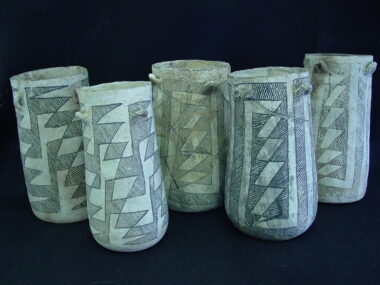
The discovery of cacao residues in ceramics from Chaco Canyon raises questions about how and when populations in the American Southwest acquired chocolate, how it was obtained from the tropical areas where cacao grows, and how populations in the American Southwest incorporated cacao into their lives. Ongoing research into the temporal and spatial distribution of cacao in the Southwest is highlighted, along with what this means for interaction with Mesoamerican populations.
While scholars have long known that southwestern populations exchanged goods with populations in Mesoamerica, our knowledge of the extent and nature of this exchange is changing as new information about cacao consumption in the American Southwest comes to light. As new information about cacao use comes to light, archaeologists are reinterpreting connections with Mesoamerica and the types of ritual activities conducted in the American Southwest.
The Spanish took control of cacao production, exchange and use soon after their arrival in Mesoamerica, and cacao consumption is not noted among the early chronicles of southwestern explorers. Yet, Spanish settlers, soldiers and priests soon reintroduced cacao into the Southwest, and it became an important commodity for interaction between the Spanish and Native American groups. Archaeological evidence and historical documents confirm the continuing allure of cacao within the scope of southwestern history.

Jonathan Till and Vaughn Hadenfeldt expose one of the wide core-and-veneer walls in the east end of the great house. Photo by Ken Abbott, CU Public Relations

The history of Southwestern archaeology is generally well known. Our understanding of the life of the prehistoric people of the Southwest is enriched daily. However, much less is known about the archaeologists themselves; their activities; their embarrassments and triumphs; their adventures and misadventures; their somber moments and their silly ones. This presentation of some anecdotes and tall tales will attempt to fill this unfortunate gap in our historical record.

Rock art is notoriously difficult to date and some dating techniques used for dating have been proven unreliable leading to considerable confusion in the literature on what is old and what is not. Using the best available dating of ancient rock art in western North America, I will discuss the present state of knowledge and present a visual perspective on the earliest styles and what they may tell us about the people who made them. Three significant styles or substyles are noted that date prior to the time of Christ. I will provide evidence for what people were doing at these early sites and consider who was making the designs and how often they were doing so. Included in the talk will be the first public presentation of data on a recently verified depiction of a mammoth and possible related Pleistocene megafauna.
- Members of the Snaketown ’65 crew
- Sarah Herr, Steve Lekson and Jenny Adams prepared to cut the cake
- Ray Thompson and the Kiva Doggerl
- ASM Director Beth Grindell pays tribute to Kiva
- Don Burgess at the Kiva Birthday Party
- Kiva reception
- Display of Hohokam Books at ASM Store
- 75 Years and counting…
- Kiva Editors
- Kiva Birthday Party
- Barneby Lewis from the Gila River Community
- Panel Session at Snaketown Symposium
- David Doyel
- AAHS President Don Burgess introducing David Doyel
- Henry Wallace, Bill Doelle and Steve Lekson – Snaketown Reception
- Snaketown Reception
- Snaketown Symposium Speakers, Patty Crown, Dave Wilcox and David Doyel
On March 5th and 6th, 2010 the Arizona Archaeological and Historical Society and the Arizona State Museum celebrated the 75th Anniversary of the excavations at Snaketown and the 75th Anniversary of it’s journal, Kiva.
From 1984 to 1987, AAHS conducted excavations at the Redtail site, an important Hohokam site in the northern Tucson Basin. The Redtail Site is part of a large Hohokam settlement complex known as the Los Morteros Community, which dates from the pioneer period through the Classsic period (AD 450-14150). The site is well known for the large number of turquoise artifacts that were uncovered there.
AAHS members are now working to curate the artifacts from this excavation using current techniques. When this process is complete a group will be put in place to do additional analyses taking advantage of of advances in analytical techiques. The results will be eventually be published. If you would like to join in either phase of this effort, curation or analysis contact Katherine Cerino. We are currently working at ASM on Tuesdsay and Thursday afternoons from 1:0o to 4:00.
